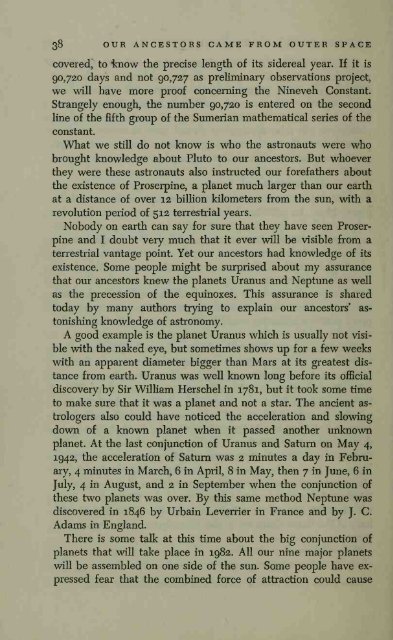Create successful ePaper yourself
Turn your PDF publications into a flip-book with our unique Google optimized e-Paper software.
38 OUR ANCESTORS CAME FROM OUTER SPACE<br />
covered, to ioiow the precise length of its sidereal year. If it is<br />
90,720 days and not 90,727 as preliminary observations project,<br />
we will have more proof concerning the Nineveh Constant.<br />
Strangely enough, the number 90,720 is<br />
entered on the second<br />
line of the fifth group of the Sumerian mathematical series of the<br />
constant.<br />
What we still do not know is who the astronauts were who<br />
brought knowledge about Pluto to our ancestors. But whoever<br />
they were these astronauts also instructed our forefathers about<br />
the existence of Proserpine, a planet much larger than our earth<br />
at a distance of over 12 billion kilometers from the sun, with a<br />
revolution period of 512 terrestrial years.<br />
Nobody on earth can say for sure that they have seen Proserpine<br />
and I doubt very much that it<br />
ever will be visible from a<br />
terrestrial vantage point. Yet our ancestors had knowledge of its<br />
existence. Some people might be surprised about my assurance<br />
that our ancestors knew the planets Uranus and Neptune as well<br />
as the precession of the equinoxes. This assurance is shared<br />
today by many authors trying to explain our ancestors' astonishing<br />
knowledge of astronomy.<br />
A good example is the planet Uranus which is usually not visible<br />
with the naked eye, but sometimes shows up for a few weeks<br />
with an apparent diameter bigger than Mars at its<br />
greatest distance<br />
from earth. Uranus was well known long before its<br />
oflBcial<br />
discovery by Sir William Herschel in 1781, but it took some time<br />
to make sure that it was a planet and not a star. The ancient astrologers<br />
also could have noticed the acceleration and slowing<br />
down of a known planet when it passed another unknown<br />
planet. At the last conjunction of Uranus and Saturn on May 4,<br />
1942, the acceleration of Saturn was 2 minutes a day in February,<br />
4 minutes in March, 6 in April, 8 in May, then 7 in June, 6 in<br />
July, 4 in August, and 2 in September when the conjunction of<br />
these two planets was over. By this same method Neptune was<br />
discovered in 1846 by Urbain Leverrier in France and by J.<br />
C.<br />
Adams in England.<br />
There is some talk at this time about the big conjunction of<br />
planets that will take place in 1982. All our nine major planets<br />
will be assembled on one side of the sun. Some people have expressed<br />
fear that the combined force of attraction could cause

















